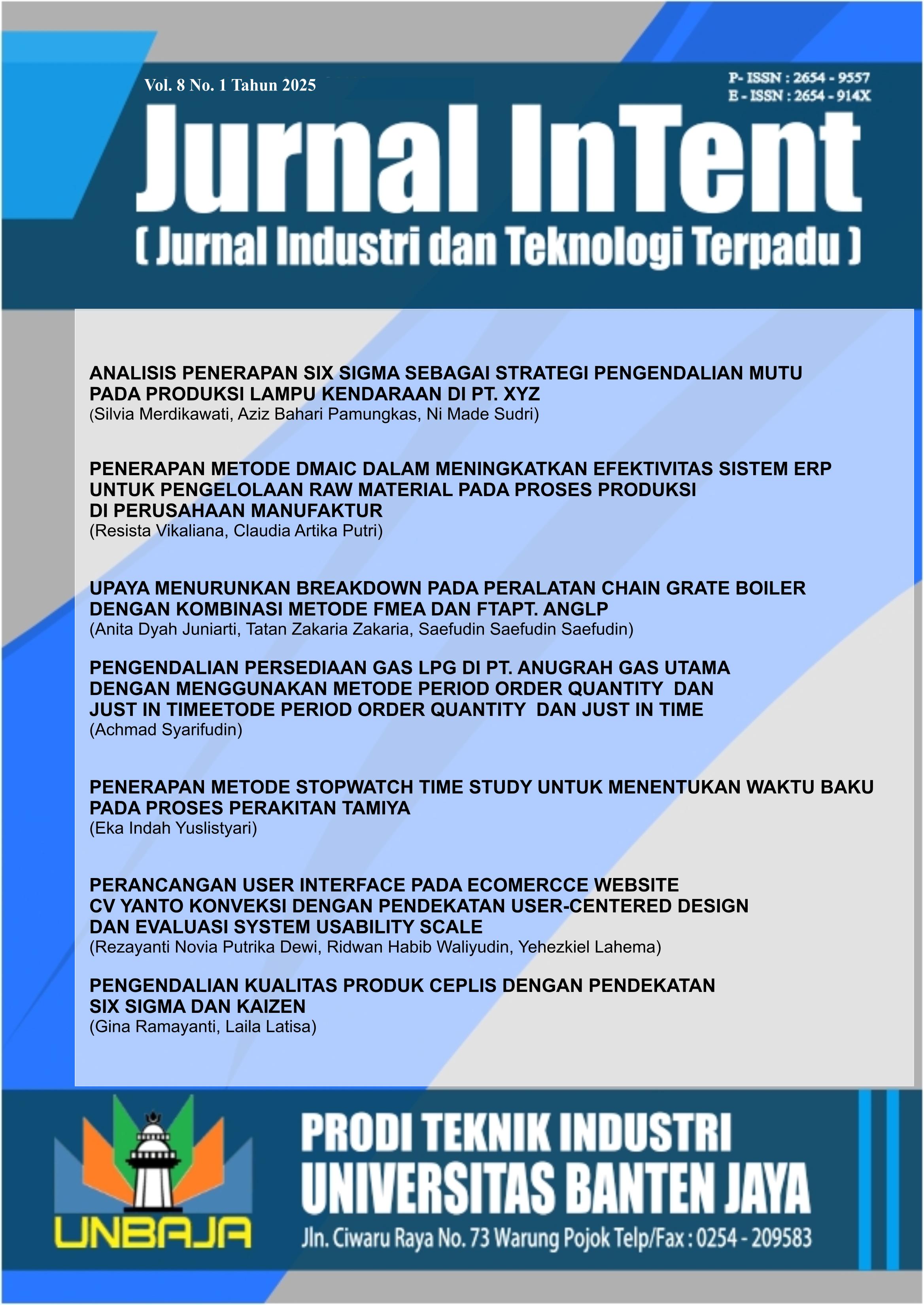PERANCANGAN USER INTERFACE PADA ECOMERCCE WEBSITE CV YANTO KONVEKSI DENGAN PENDEKATAN USER-CENTERED DESIGN DAN EVALUASI SYSTEM USABILITY SCALE
DOI:
https://doi.org/10.47080/grxy9c30Keywords:
Design, User Interface, User Centered Design, System Usability ScaleAbstract
CV Yanto Konveksi is a micro, small, and medium enterprise (MSME) providing garment manufacturing services in Tangerang Regency, marketing its products independently through conventional methods. Its marketing activities primarily rely on printed media (banners/flyers) and verbal promotion. Furthermore, the ordering process is still carried out in a conventional manner, either by visiting the business location or placing orders via telephone. This approach has proven less effective in operating the business and has resulted in limited market exposure. In line with the shift in consumer behaviour towards the use of technology, it is essential for the business to adopt an adaptive approach to ensure its continuity and growth. Based on this need, designing a user interface for an e-commerce website can facilitate potential customers in placing orders, support the company’s marketing efforts, and provide convenience to consumers when ordering products. This study employs the User-Centered Design method, in which the design is developed based on the buyers’ needs. The resulting design was evaluated using the System Usability Scale method with 50 respondents, achieving a score of 85.25 with a “Best Imaginable” rating, indicating that the website interface is of excellent quality and successfully meets user needs.
References
Aaron Bangor, Philip Thomas Kortum, dan James Thomas Miller. 2008. An Empirical Evaluation of The System Usability Scale. International Journal of Human–Computer Interaction, 24(6), 574–594.https://doi.org/10.1080/10447310802205776 diakses pada tanggal 10 Mei 2025.
Agus Arif Puji dan Venty Engraini. 2021. Perancangan User Interface Website E-Commerce pada Usaha Kuliner Menggunakan User Centered Design. Jurnal CoSciTech (Computer Science and Information Technology), 2(1), 1–8. https://doi.org/10.37859/coscitech.v2i1.2196 diakses pada tanggal 20 Juni 2025.
Andi Priti Sukma, Rampi Yusuf, dan Roviana Hendrika Dai. 2023. Analisis Pengukuran Usability Sistem Informasi Manajemen Baznas (SIMBA) Menggunakan Metode System Usability Scale (SUS). Diffusion: Journal of Systems and Information Technology, 3(2), 224–231. https://doi.org/10.37031/diffusion.v3i2.21342 diakses pada tanggal 20 Juni 2025.
Devi Lenda Kaligis dan Rini Rahayu Fatri. 2020. Pengembangan Tampilan Antarmuka Aplikasi Survei Berbasis Web Dengan Metode User Centered Design. JUST IT: Jurnal Sistem Informasi, Teknologi Informasi dan Komputer, 10(2), 106–114.https://doi.org/10.24853/justit.10.2.106-114 diakses pada tanggal 15 Juni 2025.
Donald A. Norman dan Stephen W. Draper. 1986. User Centered System Design: New Perspectives on Human-Computer Interaction. Dalam Donald A. Norman dan Stephen W. Draper (Ed.), User Centered System Design: New Perspectives on Human-Computer Interaction (pp. 1–15). Hillsdale, New Jersey: Lawrence Erlbaum Associates.
Jakob Nielsen. 1994. Usability Principles and Practice. Dalam Jakob Nielsen (Ed.), Usability Engineering (pp. 1–362). Boston: Academic Press.
John Brooke. 1996. SUS: A "Quick and Dirty" Usability Scale. Dalam Patrick W. Jordan, Bruce Thomas, Bernard A. Weerdmeester, dan Ian L. McClelland (Ed.), Usability Evaluation in Industry (hal. 189–194). London: Taylor & Francis. DOI: 10.1201/9781498710411-35 diakses pada tanggal 15 Juni 2025.
Laudon Kenneth dan Carol Guercio Traver. 2021. E-commerce 2021: Business, Technology, and Society. Edisi ke-16. London: Pearson Education.
Lisandra Maioli. 2018. Fixing Bad UX Designs: Practical Approaches and Tools to Improve User Experience. Dalam Lisandra Maioli (Ed.), Fixing Bad UX Designs (pp. xx–yy). Birmingham: Packt Publishing.
Martin Maguire. 2001. Methods to Support Human-Centred Design. International Journal of Human-Computer Studies, 55(4), 587–634.https://doi.org/10.1006/ijhc.2001.0503 diakses pada tanggal 20 Juni 2025.
Mathias Mujinga, Mariki M. Eloff, dan Jan H. Kroeze. 2018. System Usability Scale Evaluation of Online Banking Services: A South African Study. South African Journal of Science, 114(3/4), art. #2017-0065 (halaman 1–8). https://doi.org/10.17159/sajs.2018/20170065 diakses pada tanggal 20 Juni 2025.
Muhammad Arif Idris, Galang Prihadi Mahardhika, dan Beni Suranto. 2021. Perancangan UI/UX Aplikasi Perangkat Bergerak Ivent Menggunakan Pendekatan Human Centered Design (HCD). Automata, 2(1), 287–293. https://journal.unimma.ac.id/index.php/automata/article/view/5217 diakses pada tanggal 15 Juni 2025.
Nigel Bevan. 2009. What is The Difference Between The Purpose of Usability and User Experience Evaluation Methods? Proceedings of the Workshop on the Meaning of ISO 9241-210, 1–4. https://www.researchgate.net/publication/228744113 diakses pada tanggal 15 Juni 2025.
Philip Kotler dan Kevin Lane Keller. 2016. Strategic Marketing Planning. Dalam Pearson Education (Ed.), Marketing Management (edisi ke-15, hlm. seluruh buku). London: Pearson Education.
Sauro, J. 2018. Measuring Usability with the System Usability Scale (SUS). In J. Sauro. Quantifying the User Experience: Practical Statistics for User Research (pp. 201–210). Cambridge, MA: Morgan Kaufmann.
Downloads
Published
Issue
Section
License
Copyright (c) 2025 Rezayanti Novia Putrika Dewi, Ridwan Habib Waliyudin, Yehezkiel Lahema

This work is licensed under a Creative Commons Attribution-ShareAlike 4.0 International License.






